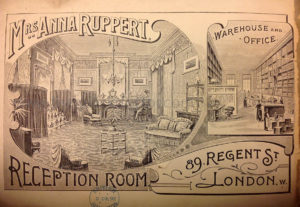
Source: The Graphic, 19 Feb 1881
.
This is a product I really don’t know much about, but I just had to feature it on the site because I love the chap’s cheerfully unsympathetic response to his friend’s agony. And the agony of corns is not to be underestimated, judging by a case study from Thomas J Ashton in 1853. He reports on a maid-servant, aged 20, who had such a painful corn on her little toe that she cut it off.
Not the corn, the whole toe. Her method was to put a knife against the toe, like a chisel, and strike it hard with a mallet. The resulting haemorrhage occasioned some alarm to her mistress, who had her taken to hospital. She eventually recovered, but the healing was complicated by the fact that there was bone sticking out and, unlike with a normal amputation, no flap of skin left to cover the wound.
Bond’s Corn Cure was only advertised for a brief period in 1881, but was part of a long tradition of salves, plasters and unspecified wonder-cures that had appeared in the papers for more than 100 years. There was also a plethora of home remedies, but the usual advice from medical writers was to wear well-fitting shoes and use pads of linen or soft leather with a hole in them – much like the modern corn plasters.
Those crippled by pain, however, could get pretty desperate, and one option was to pay an itinerant corn-cutter to treat the offending area. Some of these practitioners were more skilled than others, and some were more honest than others. From the late 18th century, they were increasingly referred to as chiropodists, but the term met with a sneering response from the faculty, who saw it as a ludicrous attempt to make the occupation sound more scientific.
The paring of corns by a family member or by the patient themself carried a risk of drawing blood and causing septicaemia, but an additional risk with corn-cutters was that of being bled of large sums of cash.
An 1846 correspondent to the Lancet described how an earl of his acquaintance was fleeced by a chiropodist known to be preying on elderly wealthy customers. The earl, aged 78, had two troublesome corns and was willing to do anything to get rid of them – including agreeing to the corn-cutter’s demand of 10s. per corn.
The operation commenced; when it was over, the corn-cutter presented my friend with a paper on which were arranged 116 corns, or dark somethings which he designated such, and smilingly announced his claim of £58!
The earl paid up and, hugely embarrassed, didn’t admit the episode to his family for several weeks – whereupon they found it hilarious and told everyone, including the doctor who wrote in to the Lancet. His opinion on what he would have done in the same situation was: “I would have made the fellow eat up his corns, and then kicked him down stairs.”
But how was it physically possible for the chiropodist to extract 116 corns from the earl’s foot? Well, it was all part of a lucrative scam carried out by more than one disreputable corn-cutter of the time. At the beginning of the procedure, the chiropodist would smear a thick ointment over the foot. Within this were shavings from horses’ hooves, which could then be plucked out and displayed to the horrified patient. Some quacks used pieces of porcupine quill, according to the Lancet, but that seems to me a lot of trouble to go to when hoof-clippings were readily available.
With such dodgy practices going on, it’s no surprise that chiropody had a bad reputation, but there were ethical practitioners too, and by this time they were beginning to recognise the need for regulation. Lewis Durlacher, Surgeon-Chiropodist to the Queen, said of corn-cutters in the preface to his 1850 work, The Foot, its Pain and Penalties:
From such men the public, being unable of themselves to distinguish between the competent practitioner and the empiric, ought to be protected either by legislative enactments, or by medical bodies licensing those who make chiropody a part of their regular medical education.
In spite of Durlacher’s attempts, however, a professional body – The Society of Chiropodists – was not established in Britain until as late as 1912.



Fascinating read… I’m still in shock at the maid chopping her toe off like…. :-O
What a fascinating article! I thought I’d share with you a receipt (recipe) for a corn remedy from Regency Etiquette: The Mirror of Graces, pub. 1811:
Take one ounce of turpentine, half an ounce of red lead, one ounce of frankincense, half a pound of white rosin, one pint of Florence oil; boil these ingredients in a pipkin, and keep stirring them over a slow fire with an elder stick until it turns black; then turn it out to harden for use. It must be applied by spreading it on a piece of leather oiled all over, and then put to the corn. Wearing it constantly for some time will effectually eradicate the corn.
Brilliant! Thanks very much for adding that.